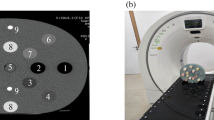Abstract
A computed tomography number to relative electron density (CT-RED) calibration is performed when commissioning a radiotherapy CT scanner by imaging a calibration phantom with inserts of specified RED and recording the CT number displayed. In this work, CT-RED calibrations were generated using several commercially available phantoms to observe the effect of phantom geometry on conversion to electron density and, ultimately, the dose calculation in a treatment planning system. Using an anthropomorphic phantom as a gold standard, the CT number of a material was found to depend strongly on the amount and type of scattering material surrounding the volume of interest, with the largest variation observed for the highest density material tested, cortical bone. Cortical bone gave a maximum CT number difference of 1,110 when a cylindrical insert of diameter 28 mm scanned free in air was compared to that in the form of a 30 × 30 cm2 slab. The effect of using each CT-RED calibration on planned dose to a patient was quantified using a commercially available treatment planning system. When all calibrations were compared to the anthropomorphic calibration, the largest percentage dose difference was 4.2 % which occurred when the CT-RED calibration curve was acquired with heterogeneity inserts removed from the phantom and scanned free in air. The maximum dose difference observed between two dedicated CT-RED phantoms was ±2.1 %. A phantom that is to be used for CT-RED calibrations must have sufficient water equivalent scattering material surrounding the heterogeneous objects that are to be used for calibration.




Similar content being viewed by others
References
IAEA TECDOC-1603 (2008) The Role of PET/CT in Radiation Treatment Planning for Cancer Patient Treatment. International Atomic Energy Agency, Vienna, Austria
Constantinou C, Harrington J, DeWerd L (1992) An electron density calibration phantom for CT-based treatment planning computers. Med Phys 19(2):325–327
Millner MR, McDavid WD, Waggener RG, Dennis MJ, Payne WH, Sank VJ (1978) Extraction of information from CT scans at different energies. Med Phys 6(1):70–71
Ebert MA, Lambert J, Greer PB (2008) CT-ED conversion on a GE Lightspeed-RT scanner: influence of scanner settings. Australas Phys Eng Sci Med 31(2):154–159
Guan H, Yin FF, Kim JH (2002) Accuracy of inhomogeneity correction in photon radiotherapy from CT scans with different settings. Phys Med Biol 47:N223–N231
Nobah A, Moftah B, Tomic N, Devic S (2011) Influence of electron density spatial distribution and X-ray beam quality during CT simulation on dose calculation accuracy. J Appl Clin Med Phys 12(3):80–89
Groell R, Rienmueller R, Schaffler GJ, Portugaller HR, Graif E, Willfurth P (2000) CT number variations due to different image acquisition and reconstruction parameters: a thorax phantom study. Comput Med Imaging Graph 24:53–58
Baxter BS, Sorenson JA (1981) Factors affecting the measurement of size and CT number in computed tomography. Invest Radiol 16:337–341
Cozzi L, Fogliata A, Buffa F, Bieri S (1998) Dosimetric impact of computed tomography calibration on a commercial treatment planning system for external radiation therapy. Radiother Oncol 48:335–338
Thomas SJ (1999) Relative electron density calibration of CT scanners for radiotherapy treatment planning. Br J Radiol 72:781–786
Kilby W, Sage J, Rabett V (2002) Tolerance levels for quality assurance of electron density values generated from CT in radiotherapy treatment planning. Phys Med Biol 47:1485–1492
AAPM Report no. 1 (1977) Phantoms for performance evaluation and quality assurance of CT scanners. Chicago, Illinois
Ebert MA, Harrison KM, Howlett SJ, Cornes D, Bulsara M, Hamilton CS, Kron T, Joseph DJ, Denham W (2011) Dosimetric intercomparison for mulitcenter clinical trials using a patient-based anatomic pelvic phantom. Med Phys 38:5167–5175
Brooks RA, Di Chiro G (1976) Beam hardening in X-ray reconstructive tomography. Phys Med Biol 21:390–398
IAEA TECDOC-1583 (2008) Commissioning of radiotherapy treatment planning systems: Testing for typical external beam treatment techniques. International Atomic Energy Agency, Vienna, Austria
ICRU Report 44 (1989) Tissue substitutes in radiation dosimetry and measurement. International Commission on Radiation Units and Measurements, Bethesda, USA
Mayles WPM, Lake R, McKenzie A, Macaulay EM, Morgan HM, Jordan TJ, Powley SK (1999) Physics aspects of quality control in radiotherapy. The Insitute of Physics and Engineering in Medicine, York
IAEA Technical Report Series no. 430 (2004) Commissioning and quality assurance of computerized planning system for radiation treatment of cancer. International Atomic Energy Agency, Vienna, Austria
Author information
Authors and Affiliations
Corresponding author
Rights and permissions
About this article
Cite this article
Inness, E.K., Moutrie, V. & Charles, P.H. The dependence of computed tomography number to relative electron density conversion on phantom geometry and its impact on planned dose. Australas Phys Eng Sci Med 37, 385–391 (2014). https://doi.org/10.1007/s13246-014-0272-y
Received:
Accepted:
Published:
Issue Date:
DOI: https://doi.org/10.1007/s13246-014-0272-y




